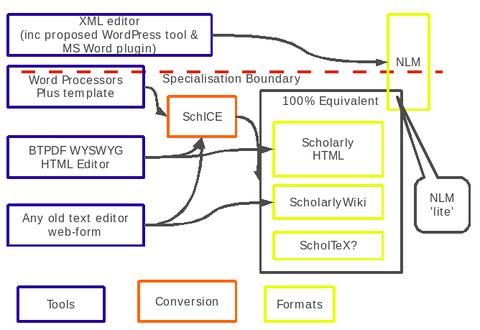I'm in Cambridge, in England. And I have given a talk as part of the
leadup to Peter Murray-Rust's Scholarly HTML hackfest.
Friday 11th March1530 Todd-Hamied Room Dept of Chemistry,
University of Cambridge
Martin Fenner , Hannover Medical School Cancer Center (DE)
Brian McMahon, Int. Union of Crystallography, Acta
Crystallographica
Peter Sefton, Univ. Southern Queensland
Martin, Brian and Peter will present ideas and get feedback in a
2-hour session 1530-1730. The blog posts below give an idea of the
material, but the themes are:
-
Authors should be able to write articles in the medium that suits
them and not have to reformat for every different publisher.
-
Authors should be able to include semantic live content
(molecules, scripts, tables, etc.)
-
The tools should help authors with tedious and trivial tasks such
as managing references, cross-referencing, packaging materials for
submissions.
-
It should be technically trivial to create new types of
publication
\
Peter's brief to me was to talk about whatever I thought was
interesting. One of the things that I find very interesting is word
processing applications and their relationship, or lack or relationship
to the web. I try not to talk about this topic at parties, not that I
get invited to many, but at a session entitled “Scholarly HTML: new approaches to
authoring scientific papers” I
should be able to at least mention Microsoft Word. Right? But more
broadly, I'm interested in how we can drag scholarship into the
twenty-first century. How can we
In this talk I thought I would talk about the relationship between
scholarly communications, computer-based authoring tools and the web.
HTML? What’s that?
Well it’s the language that the
rest of the world uses to create and publish electronic material – websites, adverts … It’s universal. It was designed to
communicate science (it happens to sell insurance as well, but science
was its motivation). It’s easy to
author. Even if you don’t like
pointy brackets there are zillions of free / open tools for creating
HTML. So it’s obvious that
scientists should use HTML for publishing.
In 1995
Working on web publishing tools for a small tech-writing group I built
automated scripts for taking styled, structured Word documents and
turning them into web pages. I thought:
-
“This is cool”.
-
And “this is really useful”.
-
And “someone else with more
entrepreneurial flair will capture a big market with this.
-
And the big one: “The next
version of Word will get this right.”
In 1997
Working on authoring tools for standards writers at Australia's national
standards body I thought:
-
“this is cool”.
-
And “this is really useful”.
-
And “someone else with more
entrepreneurial flair will capture a big market with this.
-
And the big one. “The next
version of Word will get this right.”
Still waiting for decent HTML...
-
In 2000 working on authoring tools for an .com servicing online
universities.
-
In 2005, working on a successful single-source web/print publishing
system for the University of Southern Queensland:
ICE.
-
In 2011 as part of the Beyond the PDF movement.
Scholarly HTML
Putting / doing scholarship on the web:
-
Documents plus data, provenance etc.
-
Packaging / bundling for human an machine use (Epub, ZIP).
Tools and formats

Things I'd like to show you
-
A usable interface for making structured word processing docs that
magically turn into Scholarly HTML. (See this post in the Beyond
the PDF
demonstrator
it was automatically redendered from this OpenOffice
document).
-
How we can embed high quality linked-data metadata in docs. (You can
have a 'badge' you can paste into all your papers that identifies
you as an author – like this
Peter
Sefton).
\
-
A tool for managing research objects of the future – that's papers (or theses or blog
post) plus all the supporting stuff that goes with them – see for example a chemistry
thesis
with attached Chemical Markup language files.
-
How we will be able to embed research data visualisation in a
sustainable, easy way. (We're working on embedding 3d molecule
viewers, having a few problems on the server but it Works For Me on
my laptop).
Things I hope to show you next week
-
Dead-simple packaging of rich research objects into a zip file – ready for upload to a repository,
journal deposit, etc. We have epub working, log in using OpenId and
you can covert that
thesis
to ePub, but ePub is not really suitable for bundling the CML files
– we have to work out how to
handle that.
-
Modern, rational citations built around linked data principles
rather than where the commas and full-stops are.
-
Chemistry in WordPress blogs, via Scholarly HTML.That is, linking a
document to some chemistry in the demonstator authoring enviroment,
having it pushed as declarative Scholarly HTML over the wire to a
blog and then having the blog sniff out the chemistry and use a 3d
viewer applet to show a molecule.
Copyright
Peter
Sefton,
2011. Licensed under Creative Commons Attribution-Share Alike 2.5
Australia. <http://creativecommons.org/licenses/by-sa/2.5/au/>

This post was written in OpenOffice.org, using templates and tools
provided by the Integrated Content Environment
project and published to WordPress using The
Fascinator.

